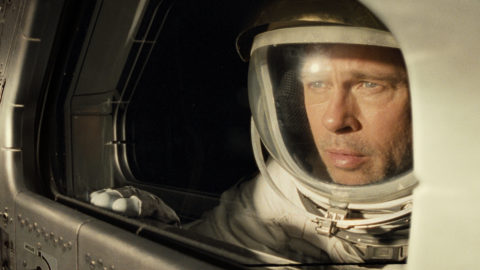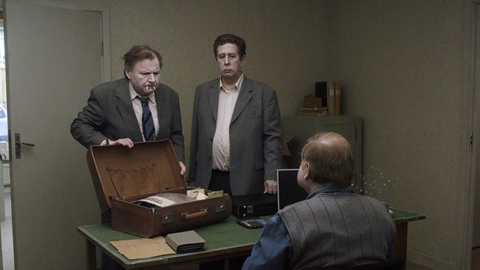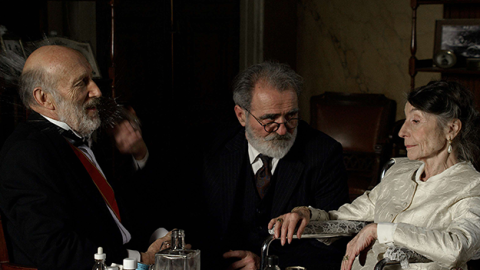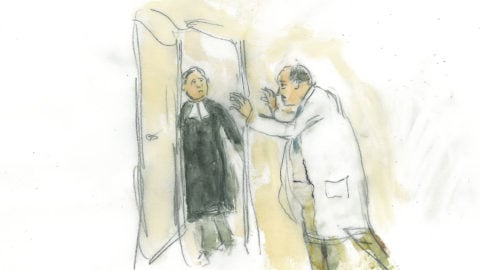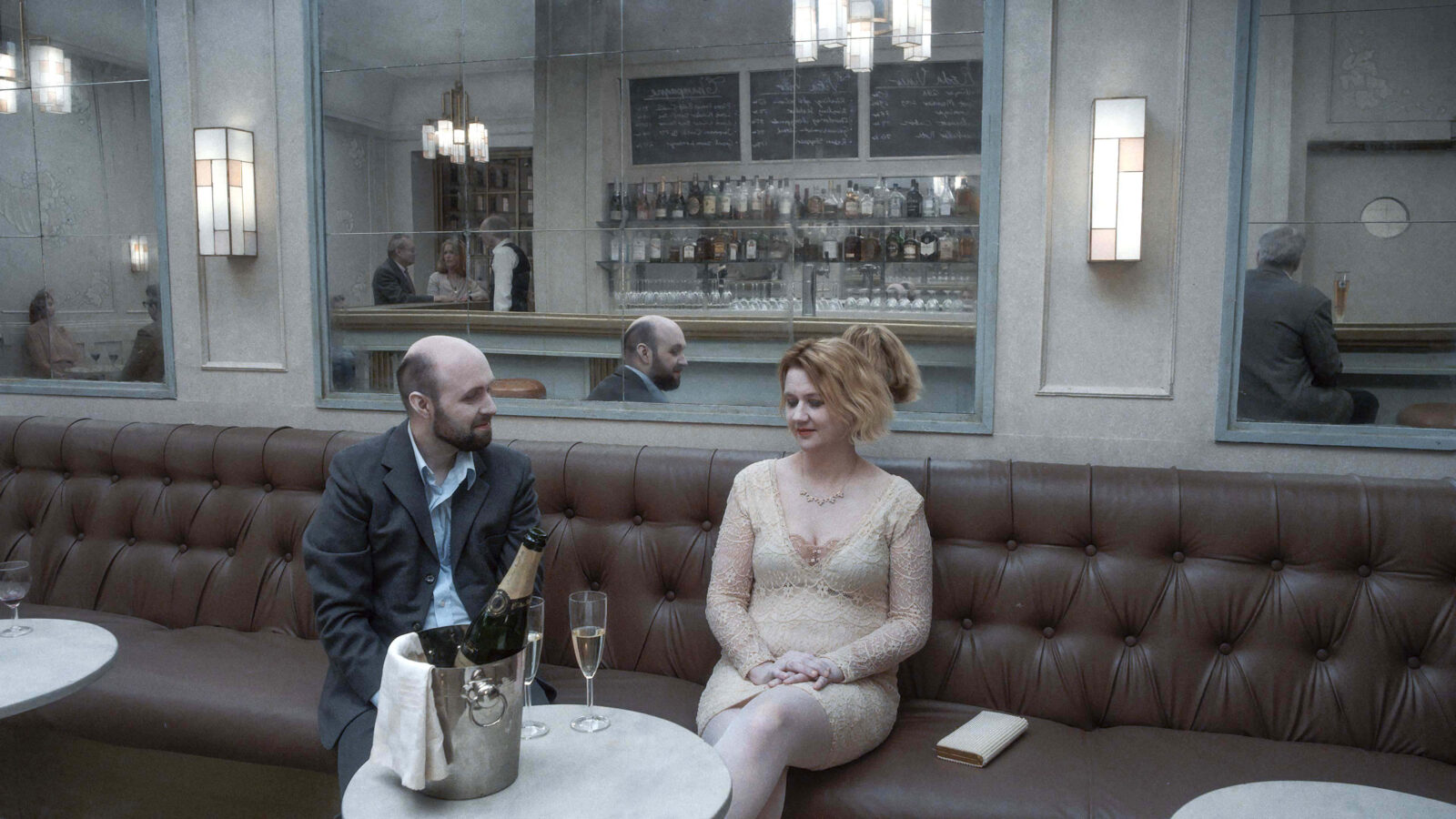
What Could Go Wrong?
The people are all pale as mushrooms, blending in with the ashen cityscapes, sterile white rooms, and drab, half-empty restaurants. Stuck in meticulously composed dioramas, they enact miniature comedies and tragedies—sometimes it is hard to say which—filled with deadpan humor and haunting bleakness. We could only be in a Roy Andersson movie, where desperate existential quandaries bump up against the implacably mundane, human suffering is met with blank-faced embarrassment, and even horrors are hushed by elegant framing and the harmony of muted colors.
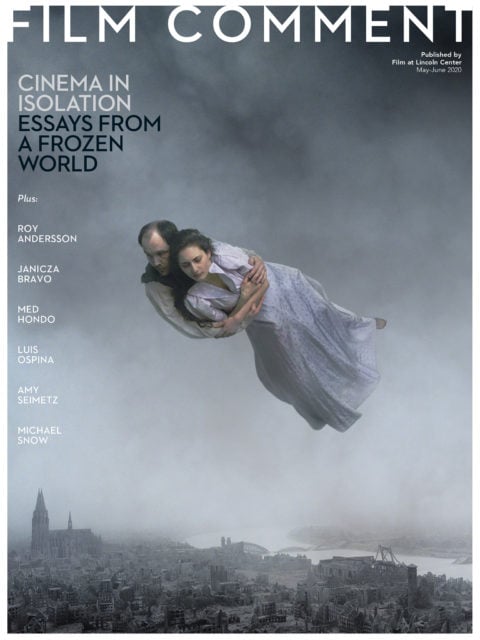
Andersson’s latest film, About Endlessness, hews to the same idiosyncratic method he established in his previous three features, collectively dubbed the “Living Trilogy.” A series of vignettes, each captured in a single, stationary shot, are linked by recurring motifs and characters but without an overarching plot. Almost every setting is constructed in the studio using painted backdrops, models, and a modicum of digital effects. (Andersson makes his movies at his own production house, Studio 24, in Stockholm.) The actors are pasty-faced and average-looking. Andersson returns often to his favorite settings: cafeterias, bars, offices, bedrooms, and train stations that all suggest the presiding spirit of Edward Hopper. The new film revisits familiar thematic obsessions—World War II, Christianity, public executions or punishments—and these weighty subjects sit cheek by jowl with episodes of banality, absurdity, and pettiness, of tiny breakdowns and modest pleasures. A woman is inconvenienced when the heel breaks off her shoe; a man gripes about the success of a former classmate; a grandmother snaps endless photos of a baby; a psychiatrist turns away a distraught priest who has lost his faith, muttering, “Sorry, but I need to catch my bus.”
In subtle ways, About Endlessness, which premiered last September at the Venice Film Festival (and in another world), feels tonally distinct from Andersson’s earlier films. Its primary mood is autumnal melancholy: the first words heard are, “It’s September already.” The treatment of war, violence, and death is more sorrowful than caustically satirical this time, and while there are episodes of cruelty and humiliation, they give way a little more often to glimpses of kindness or even joy. Since the film’s premiere, the world has become familiar with self-isolation and the random cruelty of the COVID-19 pandemic, rendering Andersson’s vision of humans’ vulnerability and life’s absurdity all the more trenchant, and his glints of hopefulness all the more welcome. In one mellow scene, patrons at an outdoor café watch three young women spontaneously dance in the street to bouncy big-band jive. Though the girls angle for attention from three young men seated at a table, the guys do not join in; they are content to look on. When the music ends, they politely clap.
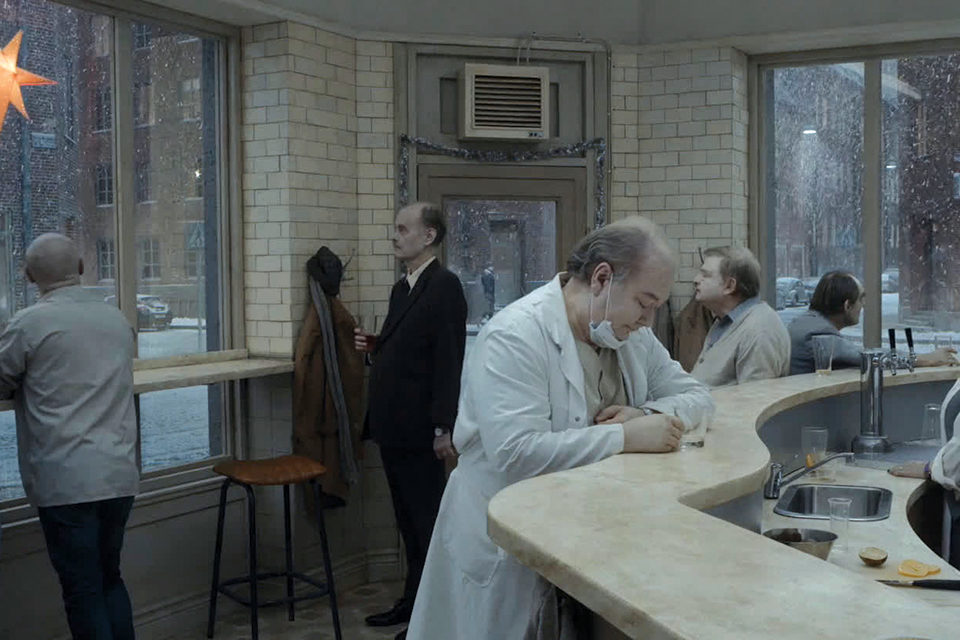
About Endlessness (© Studio 24/Roy Andersson Filmproduktion)
Bystanders like these appear in many scenes: motionless, riveted, unable to interfere or look away. In a covered market, shoppers buy fish laid out on ice, then turn to watch a man viciously slap his wife, frozen in their shocked helplessness. Riders on a tram try to ignore a disheveled man sobbing in their midst. (“Are you not allowed to be sad anymore?” one passenger asks, coming to the weeping man’s defense. Another retorts, “But why can’t he be sad at home instead?”) Two people stand in a doorway, paralyzed, looking into a room where a man cradles the daughter he has just stabbed to death. Thanks to the film’s narrator, we know that this is an “honor killing,” and that the father has had second thoughts. The voiceover is a first for Andersson, and he has said that the omniscient female speaker was inspired by Scheherazade, who told the stories of the One Thousand and One Nights to delay her execution by the Sultan. There is a slightly teasing quality in her spare commentary, with its incantatory repetition: “I saw a man who had lost his way.” “I saw a woman who had problems with her shoe.” “I saw a young man who had never found love.” “I saw a woman who thought no one was waiting for her.” The narrator too is an onlooker, like the nurse standing in the background of a dentist’s office, or the boy who stops in the street to watch a girl water a wilting potted tree. She does not tell stories; she drops hints, offers clues.
The shape of Andersson’s career is as unique as the genre he has invented. His first two features, A Swedish Love Story (1970) and Giliap (1975), were narrative films made in a more traditional style. The first, which follows the budding summer romance of two impossibly blonde young teenagers, was a popular and critical success. The second, a noir-tinged story about an enigmatic young man who comes to work at a somber hotel and is drawn into the criminal schemes and romantic desperation of the other employees, was a financial and critical disaster. Whether because of that disappointment or his own loss of interest in realism and conventional cinema, Andersson did not make another feature film for 25 years. During this period, he directed TV commercials that earned high praise from Ingmar Bergman and helped him develop and perfect a style of witty, economical, self-contained vignettes. The money from these ventures also enabled him to build Studio 24. In 2000, he returned to full-length cinema with Songs from the Second Floor, a scathing satire on commerce and capitalism. Roger Ebert, who adored the film, noted in his review that Andersson, after a quarter-century of successfully advertising corporations and their products, “now bites off the hand that fed him, chews it thoughtfully, spits it out and tramples on it.”
Because of Andersson’s time-consuming process, his films take years to finish. He followed Songs with You, the Living (2007) and A Pigeon Sat on a Branch Reflecting on Existence (2014, winner of Venice’s Golden Lion), completing the Living Trilogy. In each film, he mingles grim diagnoses of the human condition with silent-comedy-style gags, surreal fantasies, and bone-dry black humor that is as Scandinavian as pickled herring. In this world of joyless tuba players, cruelly treated animals, and glum salesmen haplessly peddling sad novelty products (“We want to help people have fun”), relief comes in the form of dream sequences, often set to music, which take flight from reality. You, the Living offers a vision of bliss in a mousy girl’s dream of marrying her punk guitarist crush and setting off for a honeymoon in a house that glides on rails like a train.
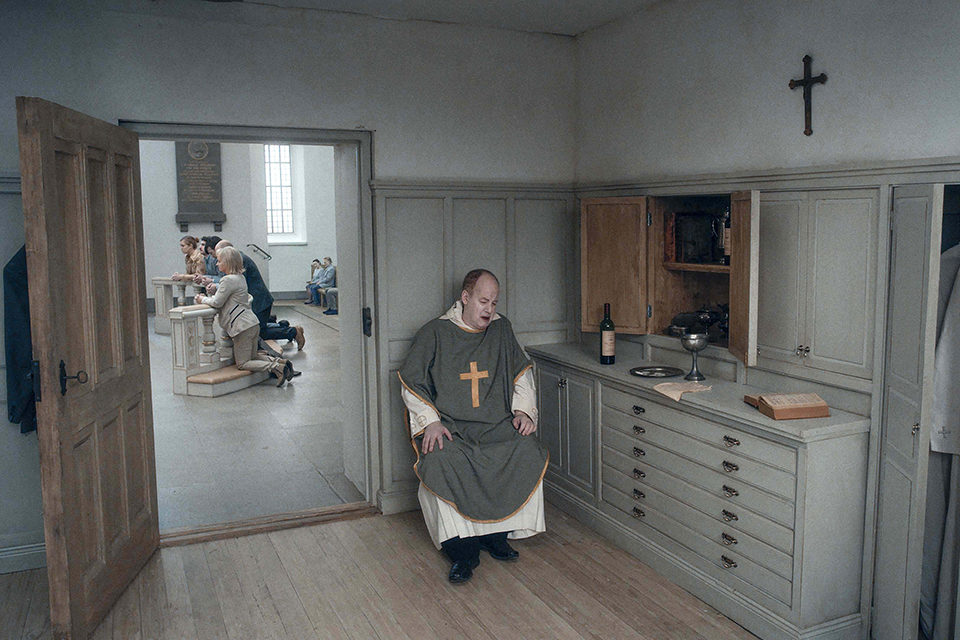
About Endlessness (© Studio 24/Roy Andersson Filmproduktion)
About Endlessness opens with a pair of flying lovers who look like ghosts from a Chagall canvas. Andersson, whose primary influences come from visual art, often bases his compositions on paintings, sometimes with a subversive twist. While Chagall’s airborne couple in the 1918 painting Over the Town are jewel-toned, levitating above a bucolic village, Andersson’s lovers are spectral, and they float over the ruins of a bombed city shrouded in mist. The scene of the father who murdered his daughter is inspired by Ilya Repin’s historical painting Ivan the Terrible and His Son Ivan on 16 November 1581, which depicts the Tsar grief-stricken after mortally wounding his son in a fit of anger—a controversial painting that has twice been vandalized by outraged Russians. Andersson himself can be a provocateur, though there is nothing in his latest film quite as transgressive as the scene in Songs from the Second Floor where a businessman angrily flings overstock crucifixes onto a junk pile, or as disturbing as the sequence from A Pigeon Sat on a Branch in which African slaves are roasted alive inside a gigantic musical contraption that produces ethereal tones for the entertainment of a decrepit colonial audience.
There is, however, a scene set in Hitler’s bunker that quotes from Dutch 17th-century interiors, perhaps a wry reference to the looted Rembrandt self-portrait hanging on the wall. In another sequence, the citizens of a contemporary Scandinavian city observe a modern-dress calvary, a man dragging a cross up the street as he is whipped and beaten by a crowd who chant, “Crucify! Crucify!” (This turns out to be a nightmare of the faithless priest, a character who reappears throughout the film.) The way that the action in Andersson’s films takes place in an unbroken stretch of time and a static point of view adds to its unsettling effect. While he draws on impeccable comic timing, he also makes deliberate use of the discomfort of waiting, and draws out bits that make us squirm in our seats.
With the format he has pioneered, Andersson reaches back to forms of proto-cinema, such as tableaux vivants, panoramas, and history paintings. The filmmaker has said he is “often very jealous of painting,” which is notable since the envy frequently runs the other way. Makers of still images, from vase paintings to photographs, have tried to capture movement, suggest duration, and evoke moments of dramatic action. Motion pictures can be seen as the culmination of humanity’s efforts to tell stories visually, from cave paintings to friezes, tapestries to scrolls, genre paintings to cartoons. But Andersson makes films that reverse this evolution, paring down cinematic techniques such as camera movement and editing. Within his frames, the eye is not guided by the lens; instead, you explore the full image in your own time, often discovering details in the background, as in a painting by Bruegel. (Andersson cited Bruegel’s The Hunters in the Snow as a touchstone for A Pigeon Sat on a Branch; curiously, this is the same painting that Abbas Kiarostami used in his 2017 feature 24 Frames to test his concept of animating still images.)
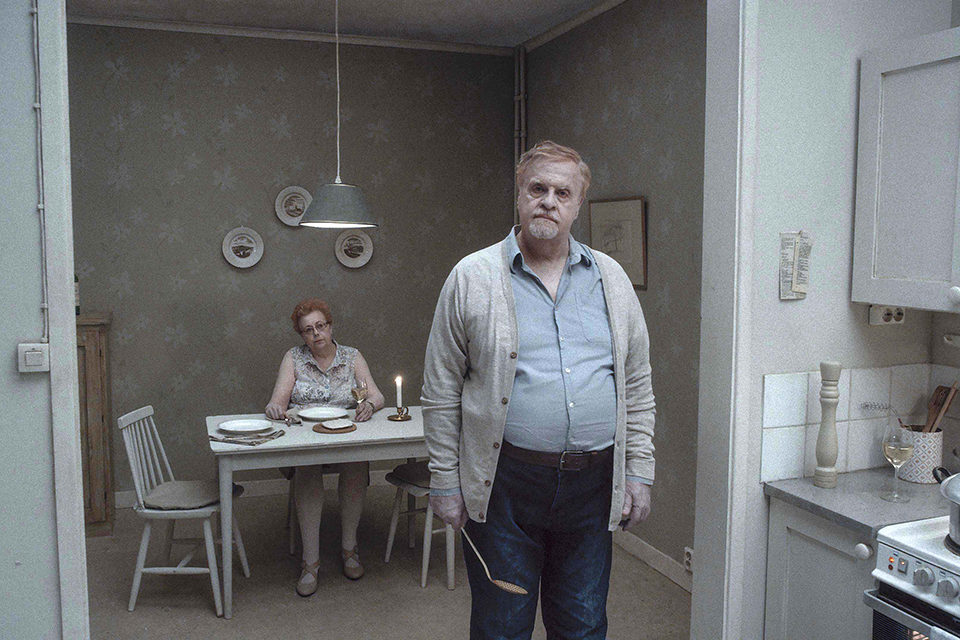
About Endlessness (© Studio 24/Roy Andersson Filmproduktion)
Andersson also eschews close-ups, keeping the viewer at a polite remove from the actors, as though they were on stage or behind glass. There are no shadows to speak of in his films; the light is uniformly bright, as in a doctor’s office. This relentlessly sharp focus relates to the clarity Andersson has praised in the works of the Neue Sachlichkeit (New Objectivity) movement of the 1920s: German artists such as Otto Dix who often focused their unflattering, satirical style on grotesque subjects, especially the aftereffects of war. Another artist whom the director has cited as an inspiration, surprisingly, is Henri Matisse—not for the painter’s voluptuous, richly colored, joyful images, to be sure, but for his philosophy of leaving out everything that is unnecessary, a goal of Andersson’s stripped-down, purified style, which he describes as “abstract.”
A mental gallery of other artists may spring to mind while watching Andersson’s films. The palette of drained yet pearly hues recalls the Danish painter Vilhelm Hammershøi, best known for intensely quiet interiors in which women face away from the viewer. Andersson’s surrealism, like Magritte’s, uses a crisp, dry precision to accentuate the strangeness of dream imagery. And while he alludes slyly to the bombast of religious and history painting, Andersson’s style more often resembles the enigmatic hints of narrative in Hopper’s works. Rather than declaring “This happened,” these pictures pose a question—“What is happening here?”—while their mute, wooden quality refuses any easy answer. Hopper’s people seem frozen in their separateness, even when his compositions imply some dynamic interaction.
In his creation of a complete, enclosed world where everything down to the tiniest detail is planned, Andersson follows in the footsteps of Jacques Tati, though his tone is much darker. Like Tati (whose work he admires), he uses sound to great effect and with masterful comic timing, as in the hilarious scene from About Endlessness in which a dentist confronts a patient who rejects the anesthetic but yelps whenever his tooth is drilled. The desire for absolute control has motivated other filmmakers who preferred to stay in the studio, like Hitchcock, whose characters can seem trapped in his airless, obsessively crafted settings. But Andersson’s method is even more stylized, recalling the work of the artist James Casebere, who constructs tabletop models of oneiric architectural spaces—flooded plantation mansions, ghostly suburbs and nighttime cities, desolate interiors that suggest monasteries, hospitals, and prisons—and photographs them so that they appear to be full-size. Producer Johan Carlsson says the goal of the Studio 24 team in bringing Andersson’s vision to life from his sketches is “making it as realistic as possible but without making it too real.” In About Endlessness, the miniature model of the bombed city (Cologne at 1:200 scale, made from laser-cut Styrofoam crumbled by hand to create the look of ruins), and the painted backdrops of a sodden soccer field or misty trees beyond a graveyard, somehow gain from being obviously artificial. They make Andersson’s people seem planted in snow globes—even a couple on a bench, gazing out over the expanse of a city across a river as a wedge of geese flies overhead; or a man stranded in a vast, bleached wasteland, tinkering with his broken-down car. How can there be any escape, when the distant horizon is a forced-perspective fake?
“Looking at art history,” Andersson says, “a lot of paintings are very tragic. But even if they depict cruel and sad scenes, by painting them the artists have in some way transferred the energy and created hope.” As the film’s title suggests, this idea of energy transfer is central to About Endlessness; it is addressed most directly in a scene where a young man tries to explain the first law of thermodynamics to his listless girlfriend. Energy cannot be created or destroyed, only changed, he says; you might come back again in a million years, but as a potato or a tomato. (“In that case, I’d rather be a tomato,” she replies.) Time, in Andersson’s films, does not flow, but rather pools. Sometimes past and present bleed into one another, as in one of the best scenes from A Pigeon Sat on a Branch, in which the Swedish King Charles XII and his army, on their way to a 1709 battle with the Russians, stop in a contemporary bar where the aides-de-camp order a sparkling mineral water for His Majesty. The recurring motifs that weave together freestanding episodes in About Endlessness illustrate how everything eventually returns, like the migrating geese seen at the beginning and again at the end. In a nearly empty restaurant, an elderly waiter (“a man whose mind was elsewhere”) pours red wine until it overflows the glass and pools on the white tablecloth, like the blood on the shirt of the girl stabbed by her father. The priest who has lost his faith glugs communion wine in the sacristy, his mouth stained dark red.
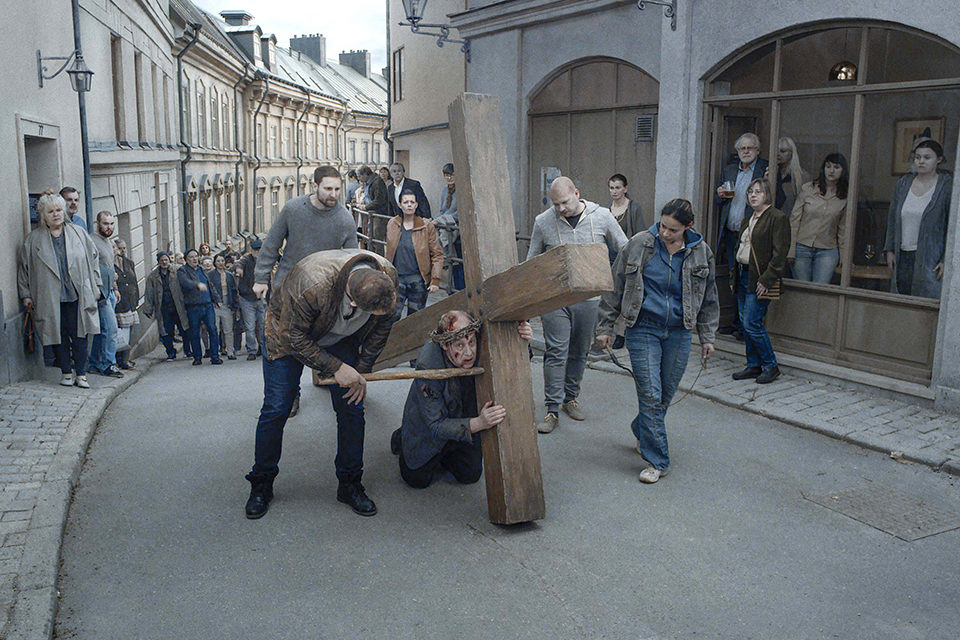
About Endlessness (© Studio 24/Roy Andersson Filmproduktion)
War is the strongest thread running through About Endlessness. A busker playing the mandolin in a subway station lost his legs to a land mine; an elderly couple puts flowers on their son’s grave and talks to him, as though placating his spirit or their own guilt. Andersson was born in Gothenberg in 1943, and as Larry Kardish has written, “the ambivalent position Sweden maintained during World War II echoes through the artist’s recurring themes of genocide, cruelty, bystander non-involvement and salvation.” His focus is always on war’s victims and losers: a man pleading for his life as he’s about to be shot by a firing squad, a defeated army marching through the snow on their way to prison camps in Siberia. In Songs from the Second Floor, the man tossing out unsold crucifixes bitterly complains that he “banked on a loser.” When Hitler appears in About Endlessness, it is clear that he too is, in every sense, a loser. “It is important to acknowledge that in the end no one is a winner,” Andersson says. “I am not a pessimistic person but the fact is: there is no hope.”
Yet the director’s penchant for heavy satire of humanity at its worst—in particular, people’s indifference to the suffering of others—has always coexisted with a more tolerant and even affectionate view of petty foibles and self-delusions. About Endlessness is especially beguiling because many of its scenes have no obvious message or punchline, but simply offer glances at everyday life. A woman and her date sit silently in a mirrored bar, Billie Holiday’s recording of “All of Me” playing softly in the background, and he pours her a glass of champagne—which, the narrator tells us, she “really, really likes.” She drinks the champagne; that is all. A father stops in the middle of a playing field in the pouring rain to tie his young daughter’s shoe as she stands holding an umbrella and a bunch of flowers. Then he picks up his own umbrella and they walk away. A woman gets off a train. All the other passengers exit the platform until she is left alone, and the train—a delicate robin’s-egg blue—pulls away to reveal a dreary, wintry, semi-industrial landscape across the tracks. She sits on a bench in the pallid near-dusk, and the feeling of loneliness is crushing. Then a rather overweight man runs panting up the stairs to greet her, and they leave together—a kind of Hollywood romantic climax cut down to the scale of real life.
To the priest who keeps agonizing over what to do now that he has lost his faith, the psychiatrist gives a simple answer: “Maybe be content with being alive.” Another man goes even further, demanding of the dour customers in a bar during a snowstorm, “Isn’t it all fantastic?” They don’t agree, exactly, but they don’t disagree; they just stand around silently, alone together, watching the snow fall. Andersson’s films, like life, are full of unanswered questions.
Imogen Sara Smith is the author of In Lonely Places: Film Noir Beyond the City and Buster Keaton: The Persistence of Comedy, and has written for The Criterion Collection and elsewhere. She writes our Phantom Light column.



